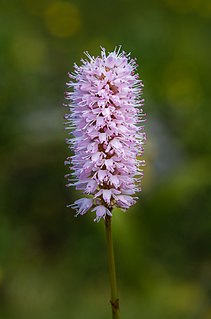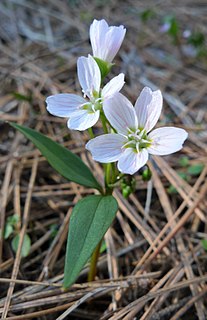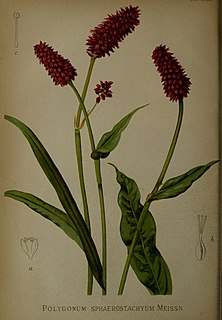
Reynoutria japonica, synonyms Fallopia japonica and Polygonum cuspidatum, is a species of herbaceous perennial plant in the knotweed and buckwheat family Polygonaceae. Common names include Japanese knotweed and Asian knotweed. It is native to East Asia in Japan, China and Korea. In North America and Europe, the species has successfully established itself in numerous habitats, and is classified as a pest and invasive species in several countries.

Bistorta officinalis, known as bistort, common bistort, European bistort or meadow bistort, is a species of flowering plant in the dock family Polygonaceae native to Europe and northern and western Asia. Other common names include snakeroot, snake-root, snakeweed and Easter-ledges.

Rubus spectabilis, the salmonberry, is a species of bramble in the rose family Rosaceae, native to the west coast of North America from west-central Alaska to California, inland as far as Idaho. Like many other species in the genus Rubus, the salmonberry plant bears edible fruit, typically yellow-orange or red in color, resembling raspberries in appearance.

Polygonum is a genus of about 130 species of flowering plant in the buckwheat and knotweed family Polygonaceae. Common names include knotweed and knotgrass. In the Middle English glossary of herbs Alphita, it was known as ars-smerte. There have been various opinions about how broadly the genus should be defined. For example, buckwheat has sometimes been included in the genus as Polygonum fagopyrum. Former genera such as Polygonella have been subsumed into Polygonum; other genera have been split off.

Oxyria digyna is a species of flowering plant in the buckwheat family (Polygonaceae). It is native to arctic regions and mountainous parts of the Northern Hemisphere.

Bistorta vivipara is a perennial herbaceous flowering plant in the knotweed and buckwheat family Polygonaceae, commonly known as alpine bistort. Scientific synonyms include Bistorta vivipara and Polygonum viviparum. It is common all over the high Arctic through Europe, North America, and temperate and tropical Asia. Its range stretches further south in high mountainous areas such as the Alps, Carpathians, Pyrenees, Caucasus, and the Tibetan Plateau.
Dragonwort is a common name for a plant which may refer to:

Claytonia is a genus of flowering plants native to Asia, North America, and Central America. The vitamin-rich leaves can be eaten raw or cooked, and the tubers can be prepared like potatoes.

Bistorta affinis, the Himalayan bistort, fleece flower, or knotweed, is a species of flowering plant in the family Polygonaceae, native to the Himalayas.

Vaccinium ovatum is a North American species of flowering shrub known by the common names evergreen huckleberry,winter huckleberry and California huckleberry.

Arctium minus, commonly known as lesser burdock, little burdock, louse-bur, common burdock, button-bur, cuckoo-button, or wild rhubarb, is a biennial plant. This plant is native to Europe, but has become introduced elsewhere such as Australia, North and South America, and other places.

Claytonia lanceolata is a species of wildflower in the family Montiaceae, known by the common names lanceleaf springbeauty and western springbeauty.

Polygonum erectum, commonly called erect knotweed, is a North American species of herbaceous plant in the buckwheat family (Polygonaceae). It is found primarily in the northeastern and north-central parts of the United States, but with scattered populations in other parts of the US and also in Canada.

Balsamorhiza sagittata is a North American species of flowering plant in the tribe Heliantheae of the family Asteraceae known by the common name Arrowleaf Balsamroot. It is widespread across western Canada and much of the western United States. A specimen was collected by explorer and botanist Meriwether Lewis near Lewis and Clark Pass in 1806.

Bistorta is a genus of flowering plants in the family Polygonaceae. As of February 2019 about 40 species are accepted. It has been supported as a separate clade by molecular phylogenetic analysis. Bistorta species are native throughout much of the Northern Hemisphere, as far south as Mexico in North America and Thailand in Asia.

Bistorta amplexicaulis, the red bistort or mountain fleece, is a species of flowering plant in the buckwheat family Polygonaceae, native to China, the Himalayas, and Pakistan. It is a damp-loving herbaceous perennial growing to 1.2 m (4 ft) tall and wide, with heart-shaped pointed leaves, downy beneath, and narrow spikes of rose-red or white flowers in summer.

Bistorta macrophylla is a flowering plant species in the buckwheat family Polygonaceae. It is native to mountain regions of West and South China, Bhutan, Nepal, northern India, and Pakistan.
Polygonum nuttallii is a North American species of flowering plant in the buckwheat family known by the common name Nuttall's knotweed. It grows in the Pacific Northwest, in British Columbia, Washington, and Oregon.
Bistorta plumosa is a flowering plant species in the family Polygonaceae, or buckwheat family. Common names for Bistorta Plumosa include meadow bistort. Bistorta plumosa is monoecious, with flowers containing both male and female reproductive parts that are pollinated by insects. Birstorta plumosa flowers annually in the summer months from May to June and can be found in habitats ranging from moist to dry sites and tundra in North America, Alaska, Yukon, the Northwest Territory, and East Asia.
















